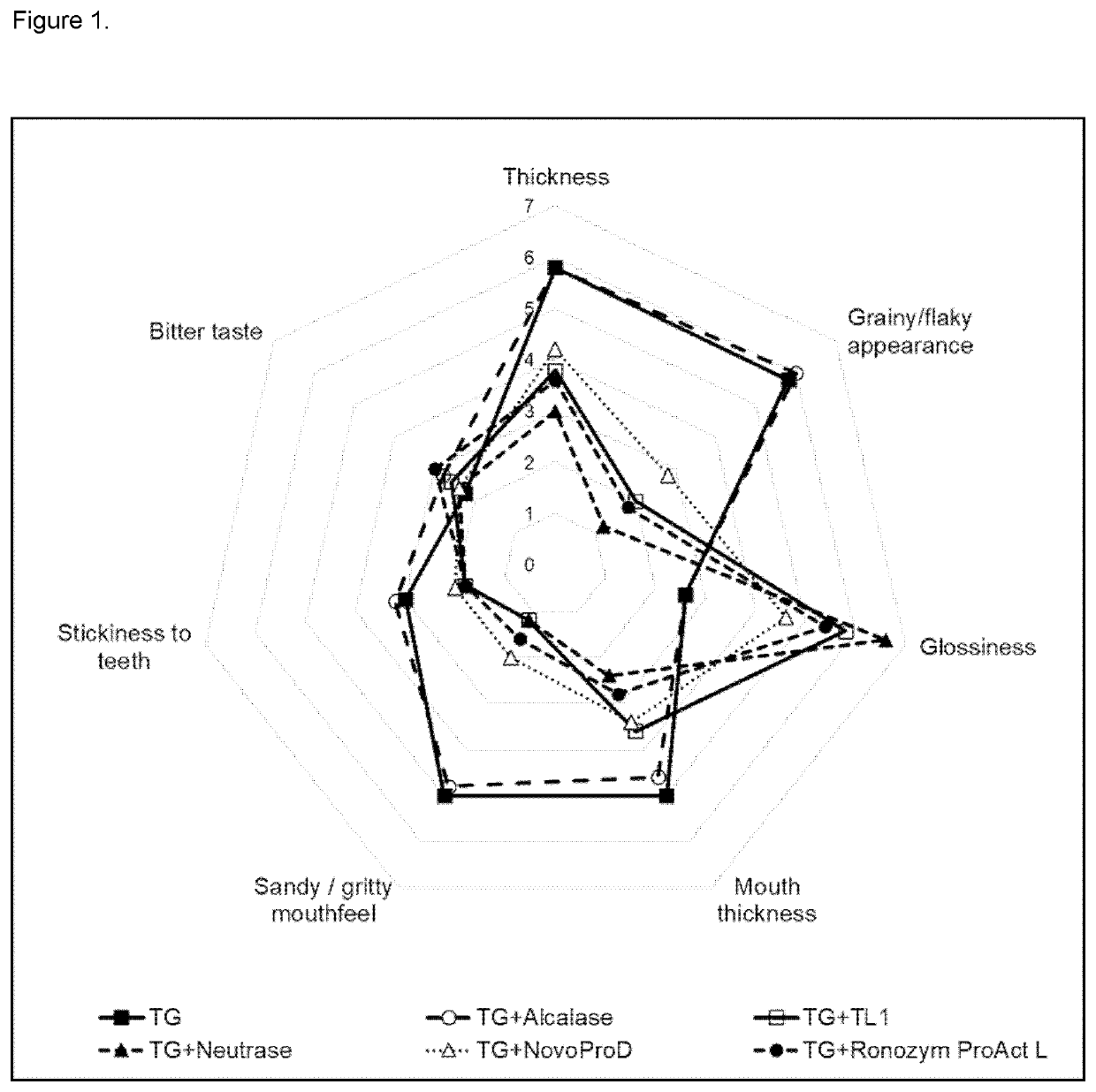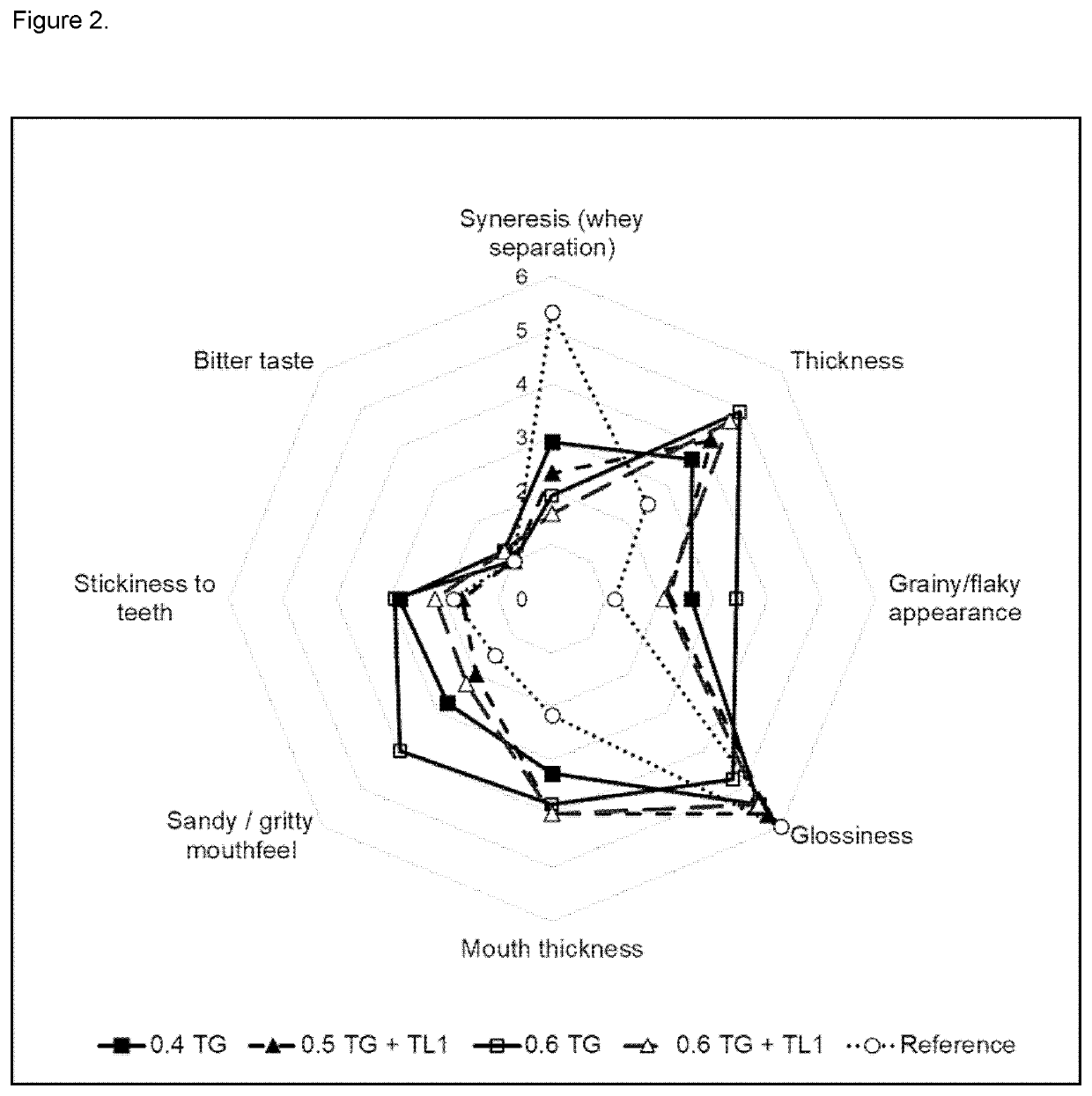Process for Preparing an Acidified Milk Product
a technology of acidification and milk product, applied in the field of preparation of acidified milk product, can solve the problems of graininess or flakiness, other texture defects, etc., and achieve the effects of reducing syneresis (whey separation), reducing graininess/flakiness, and increasing viscosity
- Summary
- Abstract
- Description
- Claims
- Application Information
AI Technical Summary
Benefits of technology
Problems solved by technology
Method used
Image
Examples
example 1
[0154]Stirred Lowfat Yoghurt Using a Combination of Transglutaminase and Various Endoproteases
[0155]The objective of this example was to compare the taste and texture of stirred yoghurts produced using a combination of transglutaminase and various endoproteases.
[0156]Production of Lowfat Stirred Yoghurt in Laboratory Scale
[0157]Low pasteurized skimmed milk with 0.5% fat content was purchased from local supermarket and used for yoghurt production without further standardization. The milk was aliquoted in 100 g portions and pasteurized at 90° C. for 5 minutes and subsequently cooled to acidification temperature 43° C. Starter culture (Lyofast Y450B, Sacco, Italy) and enzymes were added to the milk and acidification was carried out at 43° C. for 4-5 hours, until the pH had reached 4.5. Transglutaminase and endoproteases were added at the same time immediately after starter culture. The dosing of endoproteases was based on initial dose-response tests, where enzyme impact on yoghurt appe...
example 2
[0167]Pilot Scale Production of Stirred Lowfat Yoghurt Using a Combination of Transglutaminase and TL1
[0168]The objective of this example was to show that the texture of lowfat yoghurt produced using a combination of transglutaminase and TL1 was smoother compared to yoghurt produced using transglutaminase alone.
[0169]Production of Lowfat Stirred Yoghurt in Pilot Scale
[0170]Raw bovine milk was obtained from local farm and standardized to 0.1% fat and 3.5% protein content. The milk was pasteurized at 95° C. for 5 minutes and cooled to acidification temperature 43° C. Starter culture (Lyofast Y450B, Sacco, Italy) and TG (SEQ ID NO 13) and endoprotease TL1 (SEQ ID NO 1) were added to the milk and acidification was carried out at 43° C. for 5-6 hours, until the pH had reached 4.5.
[0171]The yoghurt gels were first mixed manually to break the gel, and subsequently by using a shear mixer (Ytron-Z, Ytron Process Technology, Germany). The frequency was adjusted targeting the smoothest possibl...
example 3
[0179]Stirred Whole Milk Yoghurt Using a Combination of Transglutaminase and TL1
[0180]The objective of this example was to show that a whole milk stirred yoghurt with smoother texture could be produced using a combination of transglutaminase and TL1, compared to transglutaminase alone.
[0181]Production of Whole Milk Stirred Yoghurt in Laboratory Scale
[0182]Low pasteurized whole milk with 3.5% fat content was purchased from local supermarket and used for yoghurt production without further standardization. The milk was aliquoted in 100 ml portions and pasteurized at 90° C. for 5 minutes and cooled to acidification temperature 43° C. Starter culture (Lyofast Y450B, Sacco, Italy) and transglutaminase (SEQ ID No 13) and TL1 (SEQ ID NO 1) were added to the milk and acidification was carried out at 43° C. for 4-5 hours, until the pH had reached 4.5. Two yoghurts with each treatment were produced (Table 6).
[0183]Then, the yoghurt gel was broken by using spoon and subsequently mixed using a s...
PUM
| Property | Measurement | Unit |
|---|---|---|
| storage temperature | aaaaa | aaaaa |
| storage temperature | aaaaa | aaaaa |
| temperature | aaaaa | aaaaa |
Abstract
Description
Claims
Application Information
 Login to View More
Login to View More - R&D
- Intellectual Property
- Life Sciences
- Materials
- Tech Scout
- Unparalleled Data Quality
- Higher Quality Content
- 60% Fewer Hallucinations
Browse by: Latest US Patents, China's latest patents, Technical Efficacy Thesaurus, Application Domain, Technology Topic, Popular Technical Reports.
© 2025 PatSnap. All rights reserved.Legal|Privacy policy|Modern Slavery Act Transparency Statement|Sitemap|About US| Contact US: help@patsnap.com


